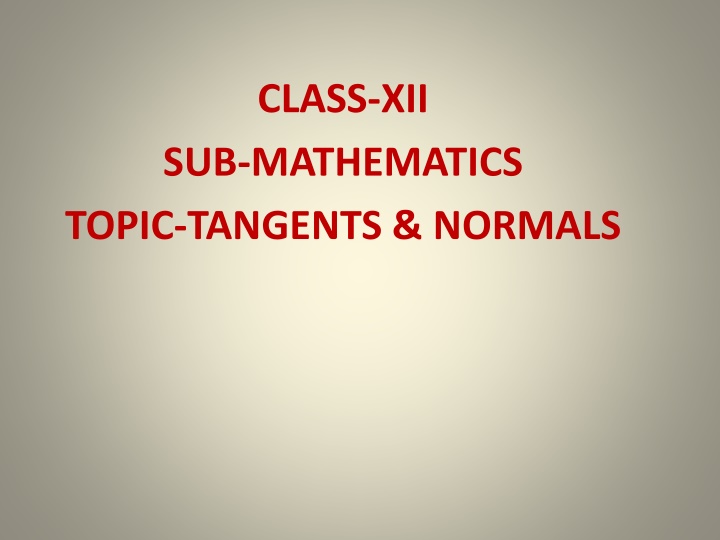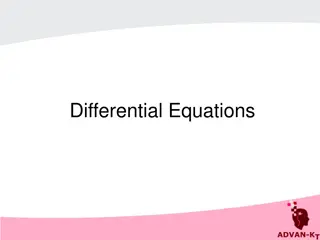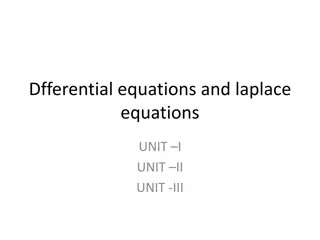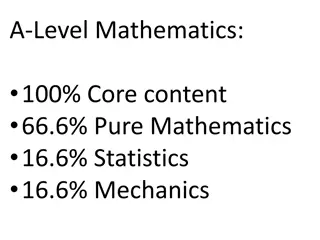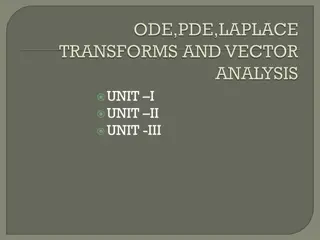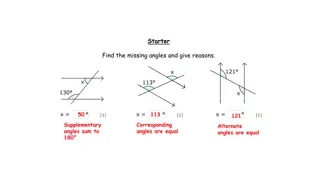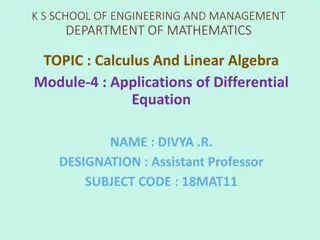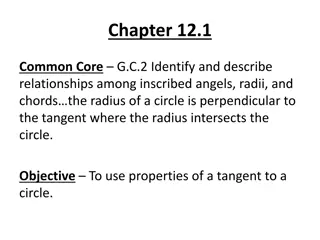Tangents and Normals in Mathematics: Equations and Applications
In mathematics, tangents and normals play a crucial role in understanding curves. Learn how to find equations of tangents and normals to curves at specific points using calculus methods. Explore the concept of gradients, curve tracing, and applications in solid geometry. Discover how to identify and calculate tangents and normals, as well as how they relate to each other. Dive into examples and analyses to deepen your understanding and application of these important mathematical concepts.
Uploaded on Feb 23, 2025 | 1 Views
Download Presentation

Please find below an Image/Link to download the presentation.
The content on the website is provided AS IS for your information and personal use only. It may not be sold, licensed, or shared on other websites without obtaining consent from the author.If you encounter any issues during the download, it is possible that the publisher has removed the file from their server.
You are allowed to download the files provided on this website for personal or commercial use, subject to the condition that they are used lawfully. All files are the property of their respective owners.
The content on the website is provided AS IS for your information and personal use only. It may not be sold, licensed, or shared on other websites without obtaining consent from the author.
E N D
Presentation Transcript
CLASS-XII SUB-MATHEMATICS TOPIC-TANGENTS & NORMALS
LEARNING OBJECTIVES 1. Introduction to equation of line & its standard form as learnt in std XI by using slope concept. 2. Identification of tangent & normal to a curve at a given point. 3. Calculating the equation of a tangent to a curve by using calculus method i,e derivatives. 4. Calculating the equation of a normal to a curve by using the perpendicular condition of slopes of lines as normal is perpendicular to tangent. 5.Orthogonal condition of two curves.i,e tangents are perpendicular at the point of intersection. 6.Application in higher mathematics especially in curve tracing & solid geometry .
INTRODUCTION Consider a function f(x) such as that shown in Figure When we calculate the derivative f of the function at a point x = a say, we are finding the gradient of the tangent to the graph of that function at that point. Figure shows the tangent drawn at x = a. The gradient of this tangent is f (a). f(x) f(a) a The tangent drawn at x = a has gradient f (a) in the form of Y=mx+c as in std XI slope m= ( y2-y1)/(x2-x1) We will use this information to calculate the equation of the tangent to a curve at a particular point, and then the equation of the normal to a curve at a point. Key Point f (a) is the(slope) gradient of the tangent drawn at x = a.
CALCULATING THE EQUATION OF TANGENT Example :-1 Suppose we wish to find the equation of the tangent to f(x) = x3 3x2+ x 1 at the point where x = 3. When x = 3 we note that f(3) = 33 3x32+ 3 1 = 27 27 + 3 1 = 2 So the point of intersection has coordinates (3, 2). The next thing that we need is the gradient of the curve at this point. To find this, we need to differentiate f(x): f (x) = 3x2 6x + 1 We can now calculate the gradient of the curve at the point where x = 3.f (3) = 3.32 6.3 + 1 = 27 18 + 1 = 10 So we have the coordinates of the required point (3, 2), and the gradient of the tangent at that Point is 10. P.T.O.
Analysis to Find the Equation of Tangent What we want to calculate is the equation of the tangent at this point on the curve. The tangent must pass through the point and have gradient 10. The tangent is a straight line and so we use the fact that the equation of a straight line that passes through a point (x1, y1) and has gradient m is given by the formula y y1 = m(x x1) y 2 = 10(x 3) y 2 = 10x 30 y = 10x 28 This is the equation of the tangent to the curve at the point (3, 2).
Example:2 Find the points on the curve y(x) given by y = x3 6x2+ x + 3, where the tangents are parallel to the line y = x + 5. Analysis:-If the tangents have to be parallel to the line then they must have the same gradient. The standard equation for a straight line is y = mx + c, where m is the gradient. So what we gain from looking at this standard equation and comparing it with the straight line y = x + 5 is that the gradient, m, is equal to 1. Thus the gradients of the tangents we are trying to find must also have gradient 1.We know that if we differentiate y(x) we will obtain an expression for the gradients of the tangents to y(x) and we can set this equal to 1. Differentiating, and setting this equal to 1 we Find dy/dx = 3x2 12x + 1 = 1 This is a quadratic equation which we can solve by factorisation. 3x2 12x = 0 3x(x 4) = 0 3x = 0 or x 4 = 0 x = 0 or x = 4 Now having found these two values of x we can calculate the corresponding y coordinates. We do this from the equation of the curve: y = x3 6x2 + x + 3. when x = 0: y = 03 6x02 + 0 + 3 = 3. when x = 4: y = 43 6x42+ 4 + 3 = 64 96 + 4 + 3 = 25. So the two points are (0, 3) and (4, 25) These are the two points where the gradients of the tangent are equal to 1, and so where the tangents are parallel to the line that we started out with, i.e. y = x + 5.
CALCULATING THE EQUATION OF NORMAL perpendicular or at right angles . The normal is a line at right angles to the tangent. In mathematics the word normal has a very specific meaning. It means (normal) (tangent) If we have a curve such as that shown in Figure , we can choose a point and draw in the tangent to the curve at that point. The normal is then at right angles to the curve so it is also at right angles (perpendicular) to the tangent. We now find the equation of the normal to a curve. There is one further piece of information that we need in order to do this. If two lines, having gradients m1 and m2 respectively, are at right angles to each other then the product of their gradients, m1xm2 = 1. Key Points If two lines, with slopes m1 and m2 are at right angles then m1xm2 = 1 Two curves are orthogonal if the tangents at their point of intersection are Perpendicular to each other.
Example :-3 f(x) = x3 3x2+ x 1 at the point where x = 3. When x = 3 we note that f(3) = 33 3x32+ 3 1 = 27 27 + 3 1 = 2 So the point of intersection has coordinates (3, 2). The next thing that we need is the gradient of the curve at this point. To find this, we need to differentiate f(x): f (x) = 3x2 6x + 1 We can now calculate the gradient of the curve at the point where x = 3.f (3) = 3.32 6.3 + 1 = 27 18 + 1 = 10=m So we have the coordinates of the required point (3, 2), and the gradient of the tangent at that Point is 10. Now the slope or gradient of normal to the curve=-1/m=-1/10 P.T.O Suppose we wish to find the equation of the normal to
Analysis to Find the Equation of Normal Now we want to calculate is the equation of the normal at this point on the curve. The tangent must pass through the point and have gradient 10. The tangent is a straight line and so we use the fact that the equation of a straight line that passes through a point (x1, y1) and has gradient m is given by the formula y y1 = -1/m(x x1) y 2 = -1/10(x 3) 10y 20 = -x +3 X+10y-23=0 This is the equation of the normal to the curve at point (3, 2).
Example-4 Find the equation of the normal to the curve f(x) = tan x at x = /4 Ans:- Now f (x)= sec2 x , At x= /4 ,f ( /4)= sec2 ( /4)= 2(slope of tangent)=m Slope of normal = -1/m=-1/2 At x= /4 , y=f( /4)=tan /4=1 point is ( /4,1) Equation of normal is, y-y1= -1/m.(x-x1) Y- 1=-1/2(x- /4) 2y-2=-x+ /4 X+2y-2= /4 8x+8y-8 =
FLOW CHART START INPUT FUCTION Y=f(x) Point P(x1,y1) N SLOPE OF THE NORMAL=-1/m SLOPE OF THE TANGENT=m CALCULATE dy/dx at P(x1,y1) =m Output equation of tangent is Y-y1=m(x-x1) Output equation of normal is Y-y1=-1/m(x-x1) STOP
THANK YOU THE END
